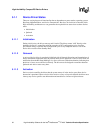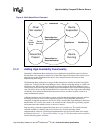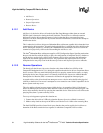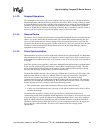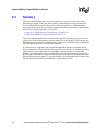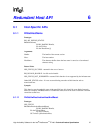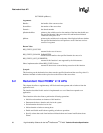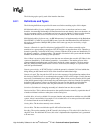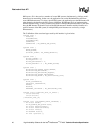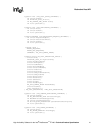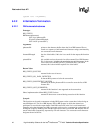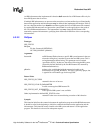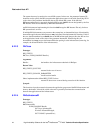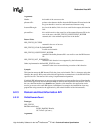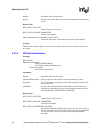
High Availability Software for the Intel
®
NetStructure
TM
ZT 4901 Technical Product Specification 39
Redundant Host API
The following topics specify each of the interface functions.
6.2.1 Definitions and Types
The following definitions are provided for terms used in the remaining topics of this chapter.
RH (Redundant Host) System. An RH system consists of two or more hosts and one or more
domains. An ownership relationship is defined between hosts and domains: hosts own domains. At
any given moment of time, no more than one host can own one domain. If a host owns the domain,
software on the host has access to PCI devices in (or behind) the PCI slots of the domain.
RH (Redundant Host) Infrastructure. An RH Infrastructure is an implementation of the Redundant
Host PICMG 2.12 APIs for a specific RH System. It provides the Redundant Host API defined in
this topic to applications. Multiple RH Systems of the same type may be serviced by a single
infrastructure.
Domain. A Domain is a specific collection of peripheral PCI slots whose ownership can be
transferred as a group among system hosts. PCI-PCI bridges can populate these slots. Therefore, a
domain is generally a collection of PCI trees (a forest). Domains in the system are identified by 32-
bit arbitrary quantities – domain numbers. The number of domains in the system and their domain
numbers are assumed static during system operation.
Host. A Host is an active entity in the system that can run software that uses this API. Hosts in the
system are identified by 32-bit arbitrary quantities – host numbers. The number of hosts in the
system and their host numbers are assumed static during the system operation. The host number
RH_NO_DESTINATION_HOST means “no host” and is used, for example, to say that no host
owns the specified domain.
Domain parent bridge. A PCI-PCI bridge is called the parent for a domain if all slots behind that
bridge belong to that domain and all slots of the domain are behind that bridge.
Domain slot path. The slot path for a PCI device is the sequence of device/function numbers from
this device up the PCI tree to its root through the sequence of PCI-to-PCI bridges. Usually (but not
necessarily) each domain has a domain parent bridge. When a host owns the domain, the slot path
of the domain parent bridge is the domain slot path with respect to the host. Domain slot path may
be defined with respect to a host even if that host does not own the domain, provided that the
domain is guaranteed to have the same slot path each time it is switched over to that host.
Switchover. Switchover is changing ownership of a domain from one host to another.
Destination Host. This is the host that receives the specified domains owned by a particular host if
a hardware-initiated switchover takes place on the owning host.
Available Host. A host is available if it can own domains and communicate with the rest of the RH
system. A host is unavailable, for example, if it is switched off or is in some special mode in which
it is isolated from the rest of the RH system.
Owning Host. The host that currently owns a domain.
Current Host. The host on which the specific API call has been made.
Root Bus. The root bus number of the PCI tree this slot belongs to. This value is 0 for the first or a
single PCI tree. For additional PCI trees, this value is implementation-dependent, but is guaranteed
to be non-zero.




